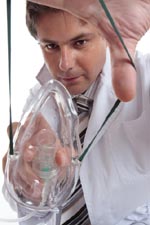First Aid for Breathing Problems

Breathing problems can be caused by illness, infection, abdominal pain, stress or as a result of injury. Whatever the cause, problems occur due to the oxygen level in the blood lowering when a person struggles to breathe.
Suffocation
When air is prevented from entering a person's lungs, the person is said to be suffocating. This could be due to a gas or fume-filled atmosphere, or the smothering of the casualty's mouth and nose.
If gas or fumes cause the suffocation, move the casualty into fresh air only if it poses little or no danger to you.
Treatment:
- Clear the casualty's face, chest and abdomen of any debris.
- If the casualty is unconscious, ensure that the airway is open, that the casualty is breathing and that there is a carotid pulse present. Act accordingly.
- All victims of suffocation, even if they are conscious and fully coherent, should get medical attention.
- Phone emergency services.
Inhaling Fumes
Depending on the source of the fumes, the effect on the casualty can be fatal. Any first-aider who attend the scene may also be in danger. Do not ever put yourself in danger!
Treatment:
- Dial emergency services.
- If it is safe to do so, evacuate the casualty into fresh air.
- If the casualty is or becomes unconscious, check that nothing is obstructing the airway, that the casualty is breathing and that there is a carotid pulse. Act accordingly.
Sudden Breathing Problems
On occasion, otherwise healthy and fit people can suddenly develop breathing problems. This could be due to anything from asthma or an allergic reaction to a collapsed lung.
You will notice:
- Rapid breathing that is shallow or deep.
You may notice:
- A rapid pulse.
- Bluish skin.
Treatment:
- If the casualty is unconscious, check that the airway is open, that the casualty is breathing and that there is a carotid pulse. Act accordingly.
- If the casualty is conscious, move him into a comfortable sitting position.
- Loosen any tight clothing.
- Dial emergency services.
Choking
Anything that lodges at the back of the throat or within the windpipe will cause a casualty to choke.
You will notice:
- Difficulty in speaking and crying.
- Difficulty in breathing.
- Acute anxiety.
You may notice:
- An inability to speak or make any sound.
- The casualty may grasp the throat.
- The casualty may become blue.
Choking in babies and young children:
- Position the baby or young child so that the head is lower than the chest.
- Sit down and hold the baby or child face down resting on your forearm.
- Support the baby's head by firmly holding the jaw.
- Rest your arm on your leg for additional support.
- Give the baby five back blows between the shoulder blades, using the flat of your hand.
- Check to see if the object has come loose.
- If this fails you will have to perform five chest thrusts.
- Turn the baby on her back between your thighs with her head nearest your knees.
- Draw an imaginary line between the baby's nipples. Place two fingers on the breastbone approximately one finger's breadth below this line.
- Give five rapid downward chest thrusts.
- If the obstruction has not moved, alternate between five backslaps and five chest thrusts.
- Dial emergency services.
- Give mouth-to-mouth (artificial respiration) to try to blow the object down so that air can at least enter one of the lungs.
- If the baby becomes unconscious, alternate between five breaths of artificial respiration, five backslaps and five chest thrusts.
Choking in adults and older children:
- Position the casualty so that the head is lower than the chest.
- Give five sharp backslaps between the shoulder blades, using the flat of your hand.
- Check to see if the object has dislodged. If it hasn't, you will have to give five abdominal thrusts.
- Stand behind the casualty and encircle his waist with your arms.
- Grasp your hands together in the upper part of the abdomen and pull upwards under the ribs. You must do this sharply. Repeat this five times.
- Check to see if the object has dislodged.
- If it hasn't moved alternate between five backslaps and five abdominal thrusts.
- If the casualty becomes unconscious, phone emergency services.
- If the casualty is not breathing, alternate between five chest compressions, five backslaps and five abdominal thrusts.
|